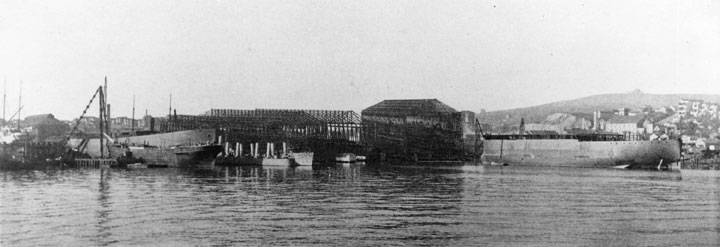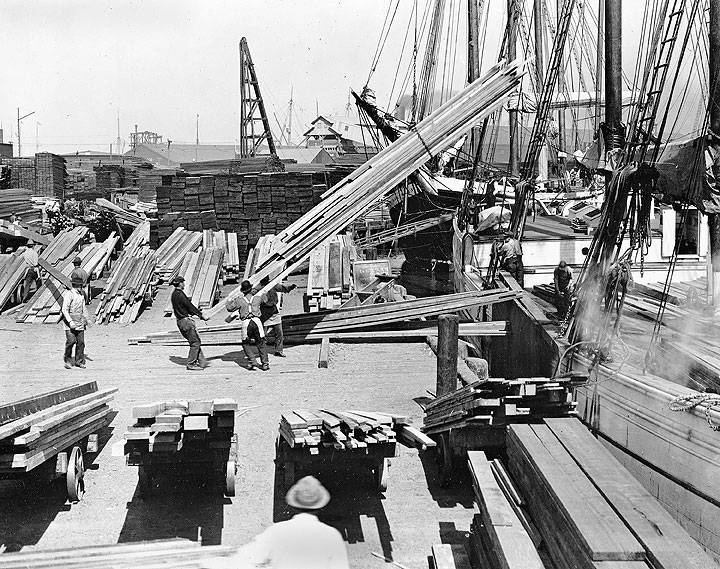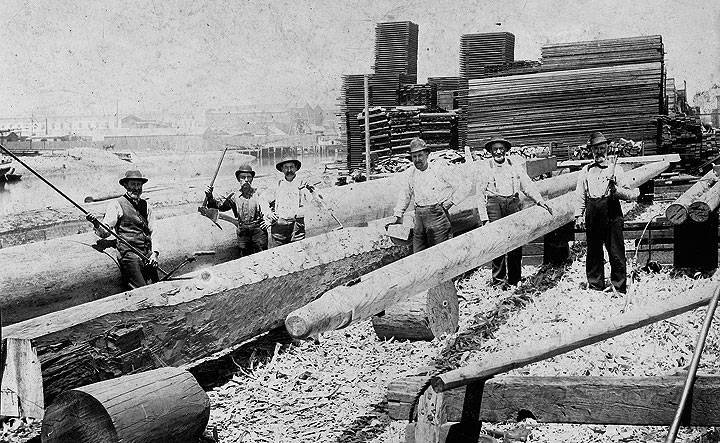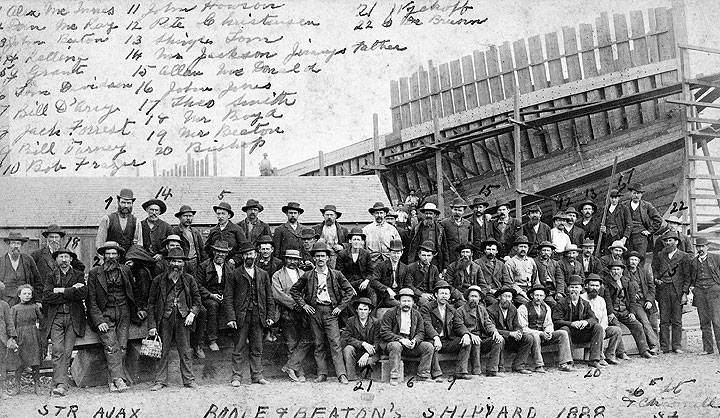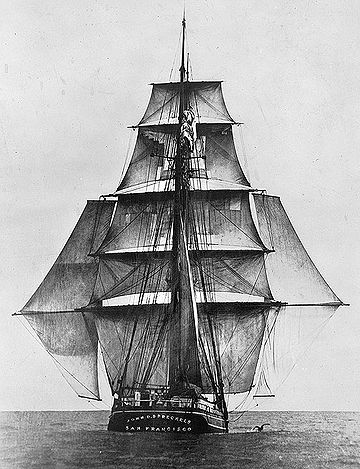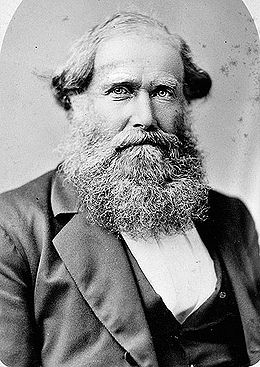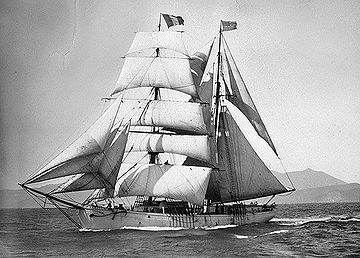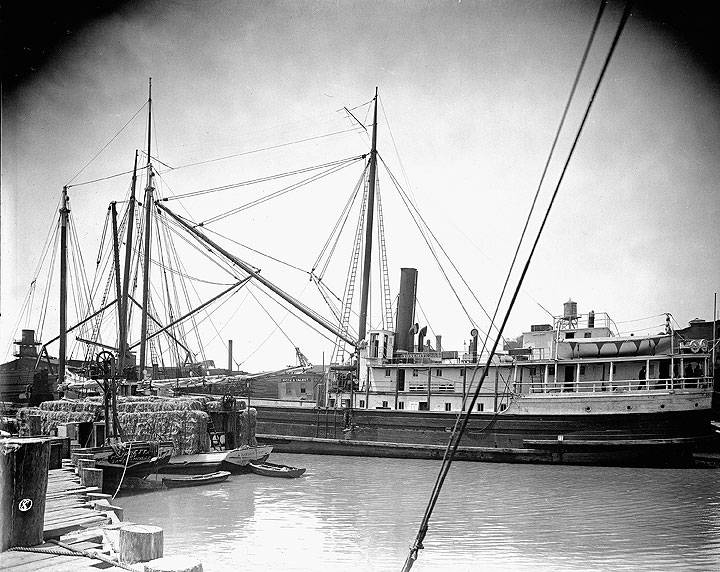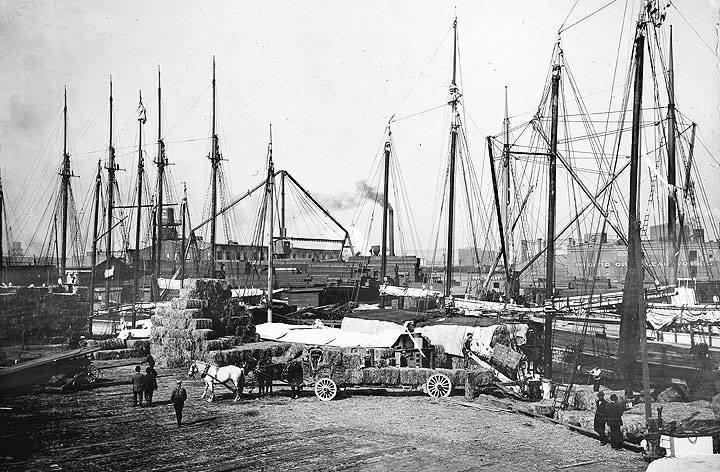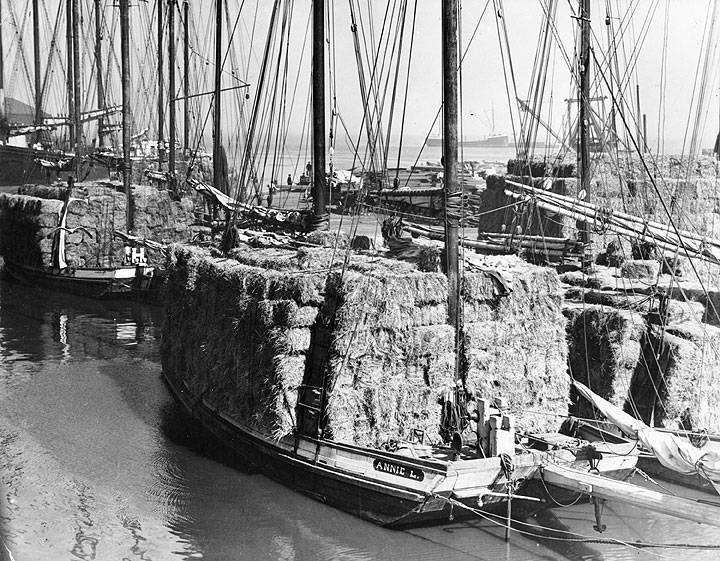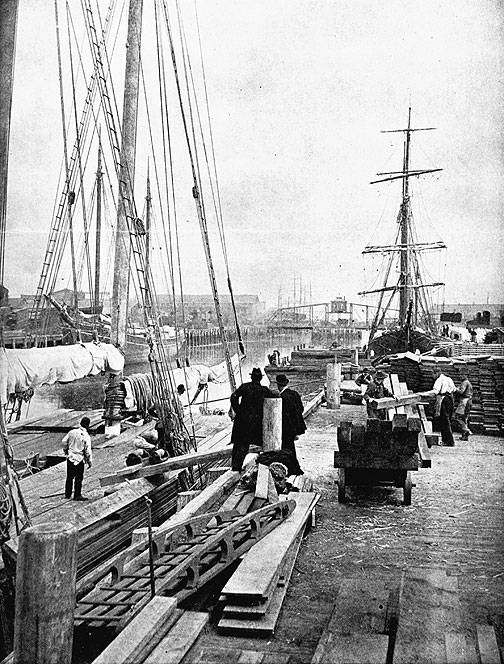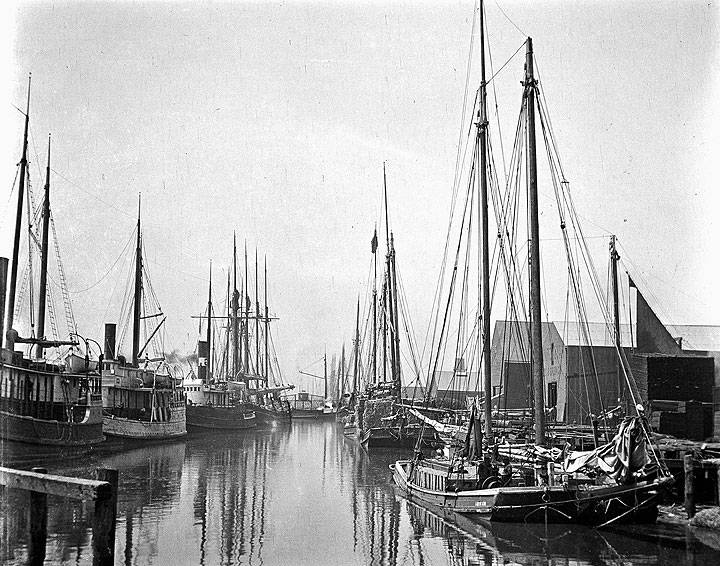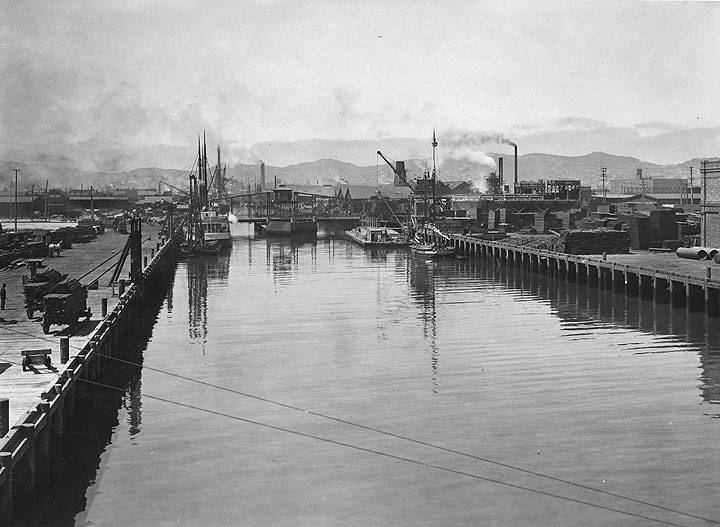Work on Land & Water, 1880-1920
Historical Essay
by Nancy J. Olmsted
View of Union Iron Works from the Bay, c. 1890s.
Photo: Bancroft Library (brk00012274_24a)
Lumber Was the Cash Crop. The big four-masted schooner Okanogan discharges lumber at the Pope & Talbot lumberyard at Third and Berry. Their wharf was on Channel Street. By the time of the Okanogan, timber was coming from the Pacific Northwest in these big four-masters. Like most of the bigger lumber companies, Pope & Talbot owned a fleet of lumber schooners to carry the rough-sawn lumber to their Channel and Berry Street yards for finishing or sale.
Photo: San Francisco Maritime National Historical Museum (A12,727nl)
In the 1880s Channel Street had deep finger-piers that extended from the back doors of Berry Street wood-finishing businesses out to meet the incoming lumber schooners and scows loaded with hay, firewood, shingles and bricks. The south side of Channel Street, from Fourth to Third, was an open wharf for lumber. The photographer has set his tripod on the southern wharf to make this three-part panorama. Among the points of interest in this early view, (1) marks the line of Fourth Street, just before Long Bridge, and the two-story warehouse of the Sierra Lumber Company, which specializes in sugar pine and yellow pine. At the next small wharf (2) is the Patent Brick Company, and stacks of lumber can be seen at the San Francisco Lumber Company (3).
Channel Street, looking toward the city, from Fourth to Third Streets, ca. 1885.
Photo: Bancroft Library
The handsome brick warehouse (4) of the South Point Warehouse Company appears on the 1869 Coast Survey Map. In this view, sacks of grain lie just beyond the two scow schooners that are moored side by side. The tallest building on the skyline (5) is the Southern Pacific’s Main Office at Fourth and Townsend. Ritch Street (6) is a small alleyway off King. The scow schooner stacked high with firewood (7) is at James Alexander’s Wood Wharf. The big gas tank (8) is at the Pacific Gas Improvement Company, between King and Townsend streets, almost adjoining the Pacific Oil and Lead Works on King Street (9). The Sacramento Brick Wharf (10) is loaded with pallets of brick. Drawn up at the foot of this wharf is yet another scow schooner, one of the workboats of the bay, flat-bottomed and, relative to its own size, capable of carrying an enormous load of bulk cargo. A diminutive tug, the kind that escorted sailing ships up the channel, noses up beside the scow. From earlier times, is the peaked roof of the South End Boat Club (11), the focus of rowing on Mission Bay in the 1880s. The large gas tank (12) is on Second Street, between King and Townsend.
Shipbuilding on the Channel 1880-1890s
Given the crowded berthing conditions on the channel after 1880, it is astonishing to see the size of the ships turned out by Alexander Hay, Matthew Turner and Boole and Beaton’s yards at the head of Mission Creek. The Boole and Beaton crew (shown below) built Tillamook, Cleone, Cosmopolis, Newsboy, Del Norte, Silver Springs, Westport, Rival and Ajax (whose hull appears behind the gang).
Sparmakers on Mission Creek. Shaping spars with broadaxe and adze started with a taste for geometry and ended with a feel for finish. A skilled man at C.A. Castner & Co., dressing down a 100-foot mast, might bring to mind the unlikely image of a sculptor smoothing his work with a ten-pound razor. The mast in the foreground is about right for a scow schooner; the one in the background looks to be about as big as they came from the Northwest woods. This view of the sparmaker’s crew, knee-deep in chips, is dated 1895—the craft is far older.
Photo: San Francisco Maritime National Historical Museum (A11.16,118n)
Boole and Beaton’s yard directly adjoined one of Alexander Hay’s two yards, the one between Sixth and Seventh streets. During 1887 and 1888 Hay produced the steam schooners Alcazar, Navarro, Point Arena, Pasadena, Noyo, Hooper, Point Lorna, Venture, Scotia, Farallon, National City, Mendocino and Jewel.106
At Boole and Beaton’s Shipyard on Channel Street. Fifty-six men stopped work on the big wooden collier (coal-carrying steamer) Ajax long enough to pose for one of the few photographs to come to light so far showing shipbuilding on Mission Creek. This view, donated by George San Faucon of the San Francisco Caulker’s Union, was made in 1888. Mr. Beaton is number 19, Mr. Boole was elsewhere.
Photo: San Francisco Maritime National Historical Museum (A4.1960n)
These two builders were the largest constructors of steam schooners on the Pacific Coast at the time—and theirs were the vessels that revolutionized the lumber trade. With their ability to deliver on contract schedule, the steam-powered lumber vessels (there was not much “schooner” about them) could be relied on winter and summer to provide the inventories builders needed. The volume of lumber carried in a year by the twenty-three vessels launched by Hay and by Boole in 1887 and 1888 was as great as an armada of sailing ships might transport.
A news clipping from 1887 headlined: “MORE SHIPBUILDING—FOUR NEW VESSELS BEING CONSTRUCTED AT THE YARDS—BUSY SAW AND HAMMER Establishing a New Shipyard at the Foot of Fifth,” describes Alexander Hay’s shipyards on the channel: “A busy scene presents itself at the Sixth Street shipyards, where four large steam schooners are being constructed, and where one, launched on Thursday, is receiving the finishing touches. At the shipyard of Alexander Hay the steamer Pasadena is well under way and will be ready for launching about the first of next month. In length she is 150 feet over all, has a breadth of beam of 32 feet and 10 feet hold. Her carrying capacity is 400,000 feet of lumber. She is constructed of Oregon pine, with stem, stern and rudder posts of eastern Oak. Her fastenings are composed of galvanized iron and locust trunnels. She is being built for Kirkoff & Kuzner of Los Angeles, who will place her in the lumber trade between the latter city and Eureka, Humboldt Bay. Her cost is $45,000.”107
After the turn of the century, the Channel Street shipbuilders moved south to Hunters Point or across the bay to Alameda and Oakland. Steam schooners began to be built increasingly closer to the source of the timber that made up their central cargo. Only a dozen steam schooners were completed in California yards after 1907, while 47 were built on the northwestern Pacific Coast.
John D. Spreckels. A handsome brigantine of 267 tons, was launched at the head of Mission Creek in 1880. She was built by Matthew Turner for Spreckels’ Hawaiian sugar trade. Like most of the vessels in that run, she carried passengers and was heavily rigged, including topmast stunsails which can been seen extended like giant wings in this picture.
Photo: San Francisco Maritime National Historical Museum (J7.15,561n)
Tahiti. Another brigantine built by Matthew Turner on Mission Creek was the Tahiti, a brig of 190 tons gross burden, launched in 1881. The handsome Tahiti fell into evil hands in 1891 when Captain W.H. Ferguson used her for “blackbirding”—recruiting coffee plantation labor by legal and illegal means. She was found bottom up near Manzanillo “with no sign of life, nor were any bodies seen floating around.”108 Matthew Turner blamed the captain for not keeping her water casks filled.
Photo: San Francisco Maritime National Historical Museum (B7.9,162n)
Hay-Day on Channel Street, 1880-1920
Captain Fred Klebingat, served as a “donkeyman,”109 when he arrived on the south waterfront in 1909 at the age of twenty. The text that follows is from his vivid recollections of Channel Street.110 “At the end of Third Street there was a narrow waterway, officially named Mission Creek, but I never heard it called by such a refined title. It was an open sewer, a cesspool that emitted offensive odors, especially at low water. Great bubbles of gas broke the surface. Here was a creek the consistency of mud; the flow of the tides did not materially affect it. We knew what the contents of the creek were! They said that if you fall overboard you’ll not last more than two minutes. They said if you took two gulps of that stuff it would be the end of you. It would turn white lead paint black in one night.
Yosemite. The steam schooner Yosemite, built in 1906 seen here c.1910-1919 at the Pope & Talbot Wharf on Mission Creek, alongside the Henrietta and the Mountain View.
Photo: San Francisco Maritime National Historical Museum (A12.9,314nl)
“As bad as the stench was, still this was the busiest place on the San Francisco waterfront. From Pope & Talbot’s Lumberyard on the north side of the entrance, and the Hay Wharf (opposite Pope & Talbot’s) steam schooners, sailing vessels and hay scows lined either side of the Creek, leaving barely enough space for vessels to be towed down the middle. A couple of drawbridges spanned the malodorous stream.
“Ships’ crews groaned at the order that brought their vessels here—the escaping gases from the creek discolored the paint of the hull inside and out. But ships came to Shit Creek in droves to discharge their lumber cargoes and bay scows came to the hay wharf to get rid of their hay deckloads.
“Men would get hungry and thirsty, even in these smelly surroundings, so several saloons and cheap restaurants were at the foot of Third Street, near the drawbridge that spanned the Creek.”
The Hay Wharf on Channel Street. “The hay dealers make a warehouse of wharves, landing their hay and keeping it there until it is peddled off,” complained the San Francisco Call in 1876. As necessary as it was to feed the thousands of horses that ran the city’s transport, the hay trade was considered an unsightly, messy fire hazard. San Francisco’s Board of Supervisors had promised the China Basin (Mission Bay) area to the harbor commission for the hay dealers but had reneged in 1876. By 1884 the hay men had their own wharf, on the north side of the channel, between Second and Third Streets, jutting off from Pope & Talbot’s lumberyard, affording only a narrow passage for scow schooners. Channel Street became the focal point of an enormous hay trade; often a dozen or more scows could be seen here at once, tied two or three abreast, loaded with five or six tiers of hay bales.
Photo: San Francisco Maritime National Historical Museum (A12.136n)
“Busiest Part of the Waterfront. . .”
Klebingat remembers
”It was Pope & Talbot’s lumber yard that we mostly visited; one thing was sure, more schooners and barkentines discharged here than in any other part of the creek. There might be a remote chance that we would meet a mate in a hurry to hire a man willing to work. Or we might meet a friend or former shipmate who was lucky and had a berth on one of these ships who might oblige us with a dollar or two.
“We watched the unloading for a while—the loads landed with the swinging gaff, tallymen standing about, a tallybook open in their left hand, noting each piece of lumber as it was removed from beneath the gear. Front men then piled the different sizes of lumber on two-wheeled carts, large clumsy affairs fitted with iron wheels. A cart is loaded, a teamster and his horse drop by. He flings a light chain over the load and cart on its high end. . . and connects it with the towing gear of his horse. They are off with the cart, its lower end dragging on the wharf, bound to a certain lumber pile where the load is stacked.
“It really never surprised us when no job was available. . . . It was one more case of—not what you knew, but WHO you knew. . . .
“Leaving Pope and Talbot we headed out the finger pier that angled out into the channel to accommodate the bay scows or scow schooners unloading hay. The scow schooners were made fast, sometimes three abreast, the inner one busy discharging its cargo . . . Several bay scows were now discharged and ready for another voyage. They moved to the outer tier, set their lowers, put down the center board, let go (some shoving off with the pike pole) and with a rubbing of strakes against their sisters they gathered headway. . . It took pure seamanship and good judgement to tack in this confined space.”
Annie L. Here the Annie L., built in 1900 by Emil Munder, at sixty-five feet long and measuring about 60 tons, brings in more than 350 bales of hay for San Francisco’s horses. Hayloads were collected from as far afield as Sacramento and Milpitas and at many points along the shallow creeks and sloughs between. There the shallow draft of a scow schooner such as the Annie L. could slide over the mud with the help of the tide, in areas closed to other types of watercraft. As vital as the hay trade was to the economy of the 19th century, hay dealers were not welcome at the wharves. During a single week in 1896, three fires started at the hay wharf were blamed on the careless manner in which scow men knocked out their pipes. Sometimes the fires spread to the scows alongside the wharf. If the mooring burned through and there was an ebb tide, a scow might drift out into the bay, burning picturesquely.111
Photo: San Francisco Maritime National Historical Museum (A12.5,017pl)
Lumber Was Big Business. A brigantine and schooner discharge lumber by hand into carts in 1897, at a yard above the Fourth Street Bridge.
Image: San Francisco Maritime National Historical Museum (A12.29.727n)
The Busiest Part of the Waterfront. Mission Creek was a narrow canal for so much activity. Captain Fred Klebingat recalled: “In 1909, when I was donkeyman on the Annie E. Smale we were discharging at Pope & Talbot’s wharves, at the entrance to Channel Creek. The hay wharves were just opposite. I was sitting in my cabin one day when lo and behold here comes the end of a bowsprit right through the porthole! There was some muffled shouting; I could hear the flapping of sails, and the next thing I knew the bowsprit backed out and was gone. It was a scow schooner, temporarily out of control. No harm done.”
Photo: San Francisco Maritime National Historical Museum (A11.29,842ps)
Mission Creek looking west from 3rd Street bridge, early 20th century.
Photo: Bancroft Library (brk00012271_24a)
This is chapter twelve of "Vanished Waters: A History of San Francisco's Mission Bay" published by the Mission Creek Conservancy, and republished here with their permission.
NOTES
106. Shipbuilding scraps, National Maritime Museum at San Francisco, p. 129ff.
107. Karl Kortum scraps. Note: Alexander Hay was located at Fifth and Berry, with his launching ways into Mission Creek, and also between Sixth and Seventh, next to Boole’s yard. Sanborn Insurance Maps, 1887, Bancroft Library.
108. Captain Fred Klebingat, Memories of the Audiffred Building & the Old City Front (San Francisco: Mills Ryland Company in cooperation with the National Maritime Museum, 1983), 14-15.
109. The steam donkey-engine was used on San Francisco docks for lifting heavy cargo. A restored donkey engine is periodically fired up for demonstration at the Historic Ships’ Project in San Francisco.
110. Captain Fred Klebingat, born in Kiel, Germany in 1889, died in Coos Bay, Oregon, in 1985. The last fifteen years of his life were spent in close correspondence and fruitful interviews with Karl Kortum, Chief Curator of the National Maritime Museum at San Francisco, as Klebingat recalled details of his many voyages in square-rigged ships and schooners that sailed every ocean of the world. An omnivorous reader and creative researcher, Klebingat, for example, had annotated R. L. Stevenson’s works as he sailed into ports earlier described in these classics. His memory of San Francisco’s turn-of-the-century waterfront was specific and honest. Maritime history is far richer for Klebingat as recorded by Karl Kortum.
111. Roger R. Olmsted interview with J. Porter Shaw, March 18, 1951.

